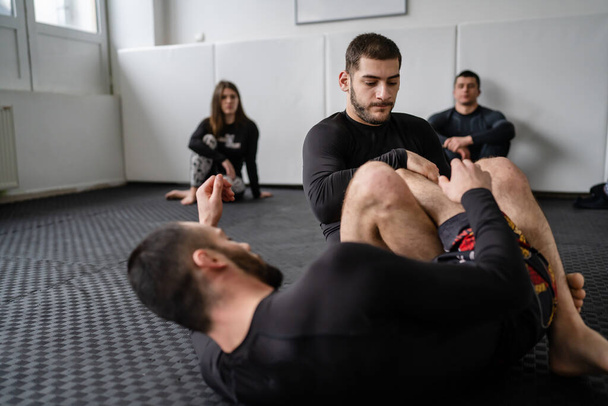Injuries in Jiu Jitsu: Prevention and Recovery
Jiu Jitsu, a martial art that originated in Japan and gained immense popularity worldwide, is known for its intricate techniques and intense physical demands. While it provides numerous benefits, including improved fitness, self-defence skills, and mental resilience, it also carries the risk of injuries. In this blog, we will explore common injuries in Jiu Jitsu, strategies for preventing them, and the crucial aspects of recovery. Whether you’re a seasoned practitioner or a beginner, understanding how to protect yourself and recover from injuries is essential for a long and fulfilling journey in this martial art.
Common Injuries in Jiu Jitsu
Before delving into prevention and recovery, it’s crucial to recognize the common injuries that Jiu Jitsu practitioners may encounter. These injuries can vary in severity, but with proper precautions, many of them can be avoided or minimised. Some of the most prevalent injuries include:
Joint Sprains and Dislocations
Joints like the shoulder, elbow, and knee are susceptible to sprains and dislocations during grappling. Overextension or sudden twists can lead to these injuries.
Muscle Strains and Tears
The dynamic movements in Jiu Jitsu can cause muscle strains and tears, often affecting the back, neck, and limbs.
Fractures
While less common, fractures can occur due to the high-impact nature of Jiu Jitsu. These injuries usually involve bones in the wrist, fingers, or toes.
Bruises and Hematomas
Repeated contact with the ground or opponent can result in bruising and hematomas, which are common but usually minor injuries.
Cauliflower Ear
This is a distinctive injury in Jiu Jitsu, caused by repeated trauma to the ear. It can result in deformities and hearing issues if not properly treated.
Preventing Injuries in Jiu Jitsu
Prevention is always better than cure. To reduce the risk of injuries in Jiu Jitsu, consider the following strategies:
Proper Warm-Up and Stretching
Begin each training session with a thorough warm-up and stretching routine. This prepares your muscles and joints for the physical demands of Jiu Jitsu.
Technique Over Strength
Focus on perfecting your technique rather than relying solely on strength. Proper technique can prevent unnecessary strain on your muscles and joints.
Listen to Your Body
Pay attention to your body’s signals. If you feel pain or discomfort during training, don’t push through it. Rest and seek medical advice if needed.
Tap Early
In Jiu Jitsu, tapping out is a crucial safety measure. When caught in a submission or a position where injury is imminent, tap to signal your opponent to release the hold.
Stay Hydrated and Nourished
Proper nutrition and hydration are essential for maintaining your body’s resilience and recovery capabilities.
Use Protective Gear
Depending on your level of training, consider using protective gear like mouthguards, knee braces, and ear protection to minimise injury risk.
Recovering from Injuries
Despite your best efforts, injuries can still occur in Jiu Jitsu. When they do, it’s essential to approach recovery in a structured and patient manner:
Immediate First Aid
If you sustain an injury during training, seek immediate first aid. Apply ice to reduce swelling, immobilise affected areas if necessary, and elevate the injured limb.
Consult a Healthcare Professional
It’s crucial to consult a healthcare professional, preferably one with experience in sports injuries. They can provide a proper diagnosis and treatment plan.
Follow Rehabilitation Exercises
If your injury allows, follow a rehabilitation program designed by a physiotherapist. These exercises can help you regain strength and mobility.
Rest and Patience
Allow your body sufficient time to heal. Rushing back into training can exacerbate injuries and lead to long-term problems.
Mental Recovery
Injuries can take a toll on your mental well-being. Stay positive, focus on your recovery, and use the downtime to study and improve your technique.
Return to Training Gradually
When cleared by a healthcare professional, return to Jiu Jitsu gradually. Start with light drilling and controlled rolls before resuming full sparring.
Jiu Jitsu in Zetland
In Zetland, like in many other places around the world, Jiu Jitsu has gained a strong following. The community here is passionate about the art, and the local academies offer excellent training opportunities. However, it’s important to emphasise that the risk of injuries exists regardless of your location. Whether you’re training in Zetland or any other part of the world, the principles of injury prevention and recovery remain the same.

Injuries are an inherent part of Jiu Jitsu, but they shouldn’t deter you from pursuing this rewarding martial art. By following proper injury prevention strategies, listening to your body, and approaching recovery with diligence and patience, you can continue your Jiu Jitsu journey while minimising the risks. Remember, safety and well-being should always be a top priority, both on and off the mat, in Zetland or anywhere else you train.


Pingback: Key Personalities Who Shaped Brazilian Jiu Jitsu History | Darwin Legend